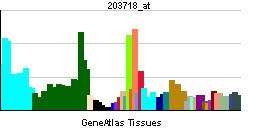Entrez 10908 | Ensembl ENSG00000032444 | |
 | ||
Aliases PNPLA6, BNHS, NTE, NTEMND, SPG39, iPLA2delta, sws, LNMS, OMCS, patatin like phospholipase domain containing 6 External IDs MGI: 1354723 HomoloGene: 21333 GeneCards: PNPLA6 | ||
Neuropathy target esterase also known as patatin-like phospholipase domain-containing protein 6 (PNPLA6) is a neuropathy target esterase enzyme that in humans is encoded by the PNPLA6 gene.
Contents
Neuropathy target esterase is a phospholipase that deacetylates intracellular phosphatidylcholine to produce glycerophosphocholine. It is thought to function in neurite outgrowth and process elongation during neuronal differentiation. The protein is anchored to the cytoplasmic face of the endoplasmic reticulum in both neurons and non-neuronal cells.
Function
Neuropathy target esterase is an enzyme with phospholipase B activity: It sequentially hydrolyses both fatty acids from the major membrane lipid phosphatidylcholine, which generates water-soluble glycerophosphocholine. In cells of eukaryotes from yeast to humans, NTE is anchored to the cytoplasmic face of the endoplasmic reticulum membrane and is particularly abundant in neurons, the placenta, and the kidney. Loss of NTE activity results in abnormally elevated levels of phosphatidylcholine in brain and impairment of the constitutive secretory pathway in neurons.
In kidney, the expression of neuropathy target esterase is regulated by TonEBP as part of osmolyte production when a concentrated urine is produced.
Clinical significance
Mutations in this gene result in autosomal recessive spastic paraplegia, and the protein is the target for neurodegeneration induced by organophosphorus compounds and chemical warfare agents.
Recessively-inherited mutations in NTE that substantially reduce its catalytic activity cause a rare form of hereditary spastic paraplegia (SPG39), in which distal parts of long spinal axons degenerate leading to limb weakness and paralysis. Organophosphate-induced delayed neuropathy— a paralysing syndrome with distal degeneration of long axons— results from poisoning with neuropathic organophosphorus compounds that irreversibly inhibit NTE.
